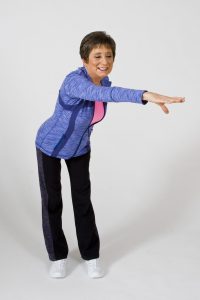
As we age, we begin to think of limitations as being part of the normal aging process. This attitude slowly pulls us into a downward spiral that leaves us feeling weak and vulnerable. This need not be our path! Take your balance for example. If you begin to notice changes in your balance and gait, it’s time to get proactive! I hope some of the information in this newsflash helps motivate and empower you turn your balance challenges into an opportunity for improvement.
Empowered To Improve Your Balance
It’s important to know if you’re at risk for falling. The best way to determine whether or not you are vulnerable is to ask your primary care physician to take you through a series of standardized fall risk assessments. If they’re unfamiliar with these testing methods, ask for a referral to a physical therapist, preferably one who specializes in balance. The benefits of working with a physical therapist are many. Not only will they identify areas of vulnerability, but they’ll provide you with specific exercises to practice which address your particular needs.
Here is a little self-test you can use to make a preliminary determination about your fall risk.
1) Have you fallen more than once during the past year?
2) Do you take 4 or more medications a day?
3) Do you feel unsteady when walking or climbing stairs?
4) When you bend or quickly turn do you feel dizzy?
5) Have you lost sensation in your legs or feet?
If you answered “yes” to one or more of the above questions, you could be at risk for a fall. Take this as a red flag. The next step is to follow up with your physician. Learn what you can do to improve your balance and reduce your fall risk. Below I’ve shared one important exercise that will get you started.
To learn more about the ramifications of a fall, check out the alarming statistics compiled by the CDC (Centers for Disease Control and Prevention) http://www.cdc.gov/homeandrecreationalsafety/falls/adultfalls.html
Become an advocate for physician education by sharing the CDC’s Steadi Initiative with your primary care doctor, especially if they’re not currently using fall risk assessments in their practice. Follow this link: http://www.cdc.gov/steadi/.

Reaching in Different Directions
One good way to challenge balance is to shift the position of your upper body in relationship to your center of gravity. Make sure you’re in a safe environment. Keep your feet firmly planted and reach forward with one arm as far as you can without taking a step or losing your balance. Repeat with the other arm. Come back to center and this time reach diagonally across they body with one arm, repeating on the other side. Engage the toes to help you keep your balance. Practice this movement daily.
Chair Exercise Basics
This new Sit and Be Fit DVD includes a 15 minute balance and gait segment as well as 2 two full body workouts and other bonus material.
Click here for more information: Chair Exercise Basics
Thank you for taking the time to read our NewsFlash!
Wishing you all the very best always,
Mary Ann Wilson, RN
